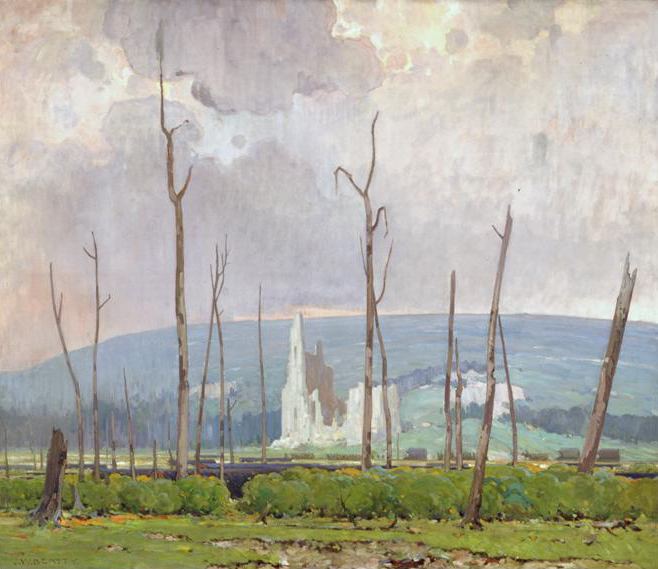 | ||
Canadian official war artists create an artistic rendering of war through the media of visual, digital installations, film, poetry, choreography, music, etc., by showing its impact as men and women are shown waiting, preparing, fighting, suffering, celebrating, These traditionally were a select group of artists who were employed on contract, or commissioned to produce specific works during the First World War, the Second World War and select military actions in the post-war period. This group includes members of the still operational Canadian Forces Artist Program.
Contents
A war artist will have depicted some aspect of war through art; this might be a pictorial record or it might commemorate how war shapes lives. The devastation of war is depicted in painting and drawing quite differently from what a camera can achieve.
The works produced by war artists illustrate and record many aspects of war, and the individual's experience of war, whether allied or enemy, service or civilian, military or political, social or cultural. The rôle of the artist and his or her work embraces the causes, course and consequences of conflict and it has been primarily an essentially educational purpose, but now is a culturally independent act of witness in contemporary Canada. Official war artists have been appointed by governments for information or propaganda purposes and to record events on the battlefield; but there are many other types of war artist.
First World War
Representative works by Canada's war artists have been gathered into the extensive collection of the Canadian War Museum. In the First World War, Canada developed an official art program under the influence of Lord Beaverbrook. He provided leadership in creating the Canadian War Records Office in London. He also established the Canadian War Memorials Fund which evolved into a collection of war art by artists and sculptors in Britain and Canada. Some of these were considered "official" war artists. For example, the English artist Alfred Munnings was employed as war artist to the Canadian Cavalry Brigade. Munnings painted many scenes, including a mounted portrait of General Jack Seely on his horse Warrior in 1918 (now in the collection of the National Gallery of Canada, Ottawa). Munnings worked on this canvas a few thousand yards from the German front lines. When General Seely's unit was forced into a hasty withdrawal, the artist discovered what it was like to come under shellfire.
Munnings also painted Charge of Flowerdew's Squadron in 1918 (now in the collection of the Canadian War Museum, Ottawa). In what is known as "the last great cavalry charge" at the Battle of Moreuil Wood, Gordon Flowerdew was posthumously awarded the Victoria Cross for leading Lord Strathcona's Horse (Royal Canadians) in a successful engagement with entrenched German forces.
The Canadian Forestry Corps invited Munnings to tour their work camps, and he produced drawings, watercolors and paintings, including Draft Horses, Lumber Mill in the Forest of Dreux in France in 1918. This role of horses was critical and under-reported; and in fact, horse fodder was the single largest commodity shipped to the front by some countries.
The "Canadian War Records Exhibition" at the Royal Academy after war's end included forty-five of Munnings canvasses.
Another example of a war artist embedded with Canadian forces was the Belgian soldier-artist Alfred Bastien whose work is part of the permanent collection of the Canadian War Museum.
Second World War
The Canadian War Records (CWR) was the name given to Canada's Second World War art program. The CWR produced two kinds of art: field sketches and finished paintings. The War Artists' Committee (WAC) recommended that the artists should attempt to share in the experience of "active operations" in order to "know and understand the action, the circumstances, the environment, and the participants." The ultimate goal was defined as "productions" which were "worthy of Canada's highest cultural traditions, doing justice to History, and as works of art, worthy of exhibition anywhere at any time."
There was a general appreciation of the need to develop what "the camera cannot interpret." The government recognized that "a war so epic in its scope by land, sea and air, and so detailed and complex in its mechanism, requires interpreting [by artists] as well as recording." On the 65th anniversary of D-Day, the war artists were recognized and addressed directly in a Ceremony of Remembrance in the Canadian Senate,
Recent conflicts
From 1946 to 2014 over 70+ civilian artists have participated in documenting the Canadian Forces. This was initially supported by the Canadian Armed Forces Civilian Artists Program (CAFCAP) and more recently by the Canadian Forces Artist Program headed by Dr. John MacFarlane.
